Eucomis comosa (E. punctata)
| Botanical Name | Eucomis comosa (E. punctata) |
|||||||||||||||||||||
| Family | Hyacinthaceae - The hyacinth family. |
|||||||||||||||||||||
| Pronunciation | YOO-com-iss kom-OH-suh |
|||||||||||||||||||||
| Common Name(s) |
English: Pineapple Flower; Pineapple Lily
Afrikaans: Wildepynappel
IsiXhosa: umphompho
IsiZulu: Umathunga
|
|||||||||||||||||||||
| Plant Group |
|
|||||||||||||||||||||
| Plant Size |
|
|||||||||||||||||||||
| Position |
|
|||||||||||||||||||||
| General Information |
|
|||||||||||||||||||||
| Specific Information | NB: The specimens in my garden and photographed above are not genetically true to Eucomis comosa, but have crossbred, quite likely with Eucomis pallidiflora subsp. pole-evansi. The distinctive, unusual flowers of Eucomis comosa are an impressive addition to the garden. This is a deciduous bulb growing from spring to autumn, after which the leaves die off for winter while the bulb has a rest period. The large bulbs are 10 to 15 cm in diameter and curiously shaped, having a flat base with the roots arranged in a frill along the outer edge. The plant forms a rosette of large, broad leaves with wavy, purple margins. The bases of the leaves and flower stalks are spotted with maroon. As the seeds ripen, the ovaries swell and darken, adding further interest to the flowers. I have grown this plant in Johannesburg as well as Bathurst with equal success. However, do consider the wind factor. The tall, top heavy stalks are easily blown over by wind, so provide a protected environment or the flowers will fall over, quite ruining their stately effectiveness. In its natural habitat, Eucomis comosa is rated on the Red Data List as 'Declining', primarily due to its collection for medicinal markets. |
|||||||||||||||||||||
| Ad Break | ||||||||||||||||||||||
| Flowers | ||||||||||||||||||||||
| Description | over a hundred star-shaped flowers, crowded around the upper half of a stout stalk, culminating in a tuft of leaves |
|||||||||||||||||||||
| Season |
|
|||||||||||||||||||||
| Colour |
|
|||||||||||||||||||||
| Growth Rate |
|
|||||||||||||||||||||
| Plant Uses |
|
|||||||||||||||||||||
| Distribution and Habitat | from the Eastern Cape to KwaZulu-Natal, along the coastal belt and inland, on damp, grassy places on hillsides, and along river and stream banks, with a summer rainfall climate . |
|||||||||||||||||||||
| Planting Suggestions | Dormant bulbs should be planted in early spring with their tops at or just below ground level, in full sun or partial shade, and protected from the full force of the wind - I have found that full sun promotes better flowers. (In very cold climates it is suggested that bulbs be planted somewhat deeper, kept as dry as possible, and covered by a thick layer of mulch in winter.) Soil must be well drained and performance will be enhanced if a top dressing of compost is given in spring. If necessary, supplement rainfall with extra water during the growing period of spring and summer. This said, I have found my plants to thrive with no other compost than their own dead leaves and the bed in which they are stored receives water only when the situation becomes critical, perhaps 2 or 3 times a year. The photos show the results of this treatment. It takes a couple of years before young bulbs begin to produce offsets, but my mature bulbs (some of them twenty-odd years old), generously produce a ring of offsets every year. These are best removed in late autumn or winter. Keep the offsets in a cool, dry place and plant out in spring. Once established, Eucomis comosa needs little attention and can be considered fully water wise. |
|||||||||||||||||||||
| Medicinal Uses | A decoction is made by boiling the bulb with other unmentioned plants. The resulting preparation, which often raises a rash, is used for rheumatism and as an enema for teething children. |
|||||||||||||||||||||
| Ad Break | ||||||||||||||||||||||


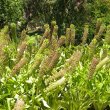
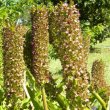
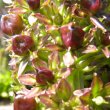
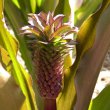
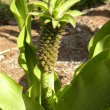

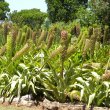
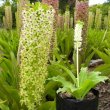


Comments
plant identification
Hie Lorraine
I need help with identifying this plant. some say its a lachnalia and others say its eucomis.
please help
TT
Ledebouria
Hi TT
Sincere apologies for taking so long to reply to your query.
This is neither Eucomis or Lachanalia. It is a species of the Genus Ledebouria, (possibly Ledebouria marginata).
Visit the following sites,so that you can compare the flowers of the three plant groups.
https://www.google.co.za/search?q=eucomis&biw=1920&bih=938&source=lnms&t...
https://www.google.co.za/search?q=lachenalia&source=lnms&tbm=isch&sa=X&v...
http://kumbulanursery.co.za/plants/ledebouria-revoluta
Kind regards
Lorraine
Discuss this plant
Share knowledge, ask a question or give an experience.